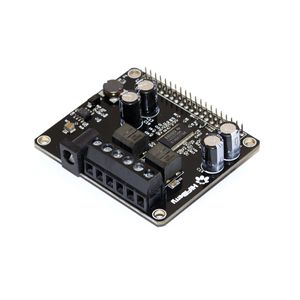Difference between revisions of "HiFiBerry Amp2"
| Line 23: | Line 23: | ||
== Output Filtering == | == Output Filtering == | ||
| − | '''WARNING:''' while the part is rated up to 192kHz, there seems to be a low-pass filter applied to the amplifier, see here: https://support.hifiberry.com/hc/en-us/community/posts/360014295118-Ultrasonic-frequency-response?mobile_site=true | + | '''WARNING:''' while the part is rated up to 192kHz, there seems to be a low-pass filter applied to the amplifier to filter above 20kHz, see here: https://support.hifiberry.com/hc/en-us/community/posts/360014295118-Ultrasonic-frequency-response?mobile_site=true |
Efforts to bypass the filter are ongoing. It should be possible to reconfigure the filter if it is a DSP filter, or remove the components if it is a hardware filter. According to the datasheet ( {{#show: TAS5756M | ? Has Datasheet=}} , page 60) the amplifier is commonly used with a passive LC lowpass filter. | Efforts to bypass the filter are ongoing. It should be possible to reconfigure the filter if it is a DSP filter, or remove the components if it is a hardware filter. According to the datasheet ( {{#show: TAS5756M | ? Has Datasheet=}} , page 60) the amplifier is commonly used with a passive LC lowpass filter. | ||
| + | |||
| + | Looking at the board, it seems as if the large black components next to the speaker output are the inductors, and the capacitors on either side are the other components in the filter. The datasheet discusses a filterless mode, so it should be possible to bypass the filter by removing those components and shorting the pads on either side of the inductor. | ||
Revision as of 22:52, 20 August 2021
| HiFiBerry Amp2 | |
|---|---|

| |
| Modality | Audio |
| Part Type | Raspberry Pi HAT |
| Manufacturer | HiFiBerry |
| Product ID/Part Number | Amp2 |
| Product Page | https://www.hifiberry.com/shop/boards/hifiberry-amp2/ |
| Datasheet | File:Https://www.hifiberry.com/docs/data-sheets/datasheet-amp2/ |
| Price (USD) | 49.90 |
| HiFiBerry Amp2 | |
|---|---|
| Uses Interface(s) | I2C |
| HiFiBerry Amp2 | |
|---|---|
| Uses (Board-Numbered) GPIO Pin(s) | 3, 5, 12, 35, 38, 40, 7 |
| Provides Backpower | Yes |
| Computer Card Type | DAC |
The HiFiBerry Amp 2 is an integrated Amplifier and Sound Card HAT for the Raspberry Pi capable of playing audio at 24 bits/192kHz.
The Amplifier chip used is TAS5756M
Output Filtering
WARNING: while the part is rated up to 192kHz, there seems to be a low-pass filter applied to the amplifier to filter above 20kHz, see here: https://support.hifiberry.com/hc/en-us/community/posts/360014295118-Ultrasonic-frequency-response?mobile_site=true
Efforts to bypass the filter are ongoing. It should be possible to reconfigure the filter if it is a DSP filter, or remove the components if it is a hardware filter. According to the datasheet ( Tas5756m.pdf , page 60) the amplifier is commonly used with a passive LC lowpass filter.
Looking at the board, it seems as if the large black components next to the speaker output are the inductors, and the capacitors on either side are the other components in the filter. The datasheet discusses a filterless mode, so it should be possible to bypass the filter by removing those components and shorting the pads on either side of the inductor.
Configuration
Note that the following is encapsulated in the autopilot script hifiberry, which can be executed with
python -m autopilot.setup.run_script hifiberry
Device Tree
In /boot/config.txt, remove or comment out the following to disable the built-in audio[1]:
dtparam=audio=on
And add the line:
dtoverlay=hifiberry-dacplus
ALSA
Optionally, you can make the card the default sound-card for ALSA by creating a /etc/asound.conf file with the following
pcm.!default {
type hw card 0
}
ctl.!default {
type hw card 0
}
GPIO Usage
The following pins are reserved and can't be used for other purposes[2]:
| Board Pins | BCM # | Use |
|---|---|---|
| 3, 5 | 2, 3 | I2C Configuration |
| 12, 35, 38, 40 | 18-21 | Sound interface |
| 7 | 4 | Mute -- pulling low mutes (so pull it up!) |
Specs
Recommend powering with an 18V power supply!
| Recommended operating voltage | 12-20V | |
| Absolute maximum operating voltage | 24V | |
| Maximum output power | 60W | |
| THD+N | <0.02% | typical, output power 0.1-10W |
| SNR | 104db | typical |
| Frequency response | 20-20000Hz | output filter characteristics depending on specific speaker parameters |
| Typical output power per channel | 14W | Vsupply=12V, Rspk = 4Ohm, THD+N <0.1% |
| 18W | Vsupply=18V, Rspk = 4Ohm, THD+N <0.1% | |
| 20W | Vsupply=24V, Rspk = 4Ohm, THD+N <0.1% | |
| 8W | Vsupply=12V, Rspk = 8Ohm, THD+N <0.1% | |
| 17W | Vsupply=18V, Rspk = 8Ohm, THD+N <0.1% | |
| 28W | Vsupply=24V, Rspk = 8Ohm, THD+N <0.1% | |
| Maximum output power per channel | 15W | Vsupply=12V, Rspk = 4Ohm, THD+N <10% |
| 30W | Vsupply=18V, Rspk = 4Ohm, THD+N <10% | |
| 44W | Vsupply=24V, Rspk = 4Ohm, THD+N <10% | |
| 10W | Vsupply=12V, Rspk = 8Ohm, THD+N <10% | |
| 20W | Vsupply=18V, Rspk = 8Ohm, THD+N <10% | |
| 38W | Vsupply=24V, Rspk = 8Ohm, THD+N <10% | |
| Sample rates | 44.1-192kHz |